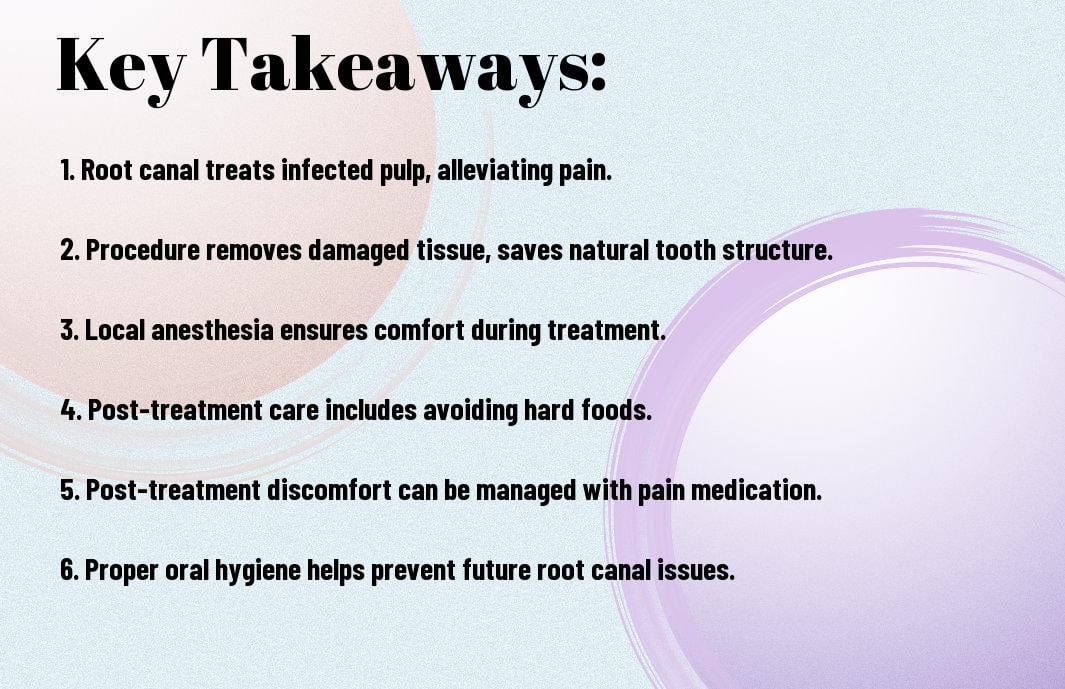With advancements in modern dentistry, a root canal treatment is now a common procedure to alleviate severe tooth pain caused by infected or damaged pulp. This treatment not only eliminates the need for extraction but also preserves the natural tooth structure, preventing further complications and restoring oral health. By stepping into the process, benefits, and misconceptions of root canal treatment, we aim to provide a comprehensive guide to help you make an informed decision about this crucial dental procedure.
Key Takeaways:
- Root canal treatment can alleviate severe pain caused by infected or damaged tooth pulp, by removing the infected tissue and preserving the natural tooth.
- Modern advancements in dentistry have made root canal procedures more comfortable, efficient, and successful, often completed in a single visit with minimal discomfort.
- Timely intervention and seeking professional dental care when experiencing tooth pain or sensitivity can help save the tooth and prevent further complications that may require extraction.
The Anatomy of a Tooth
Tooth Structure and the Root Canal System
Before delving into the details of root canal treatment, it’s vital to understand the basic anatomy of a tooth and the intricate root canal system. The outer layer of a tooth is composed of enamel, the hardest substance in the human body, which protects the inner layers.
Common Causes of Tooth Pulp Damage
An important aspect to consider is how tooth pulp damage occurs. Common causes include deep decay, repeated dental procedures on the tooth, cracks or chips in the tooth, or trauma to the face. When the pulp becomes damaged or infected, it can lead to severe pain, sensitivity to hot or cold, swelling, and even abscesses.
To prevent irreversible damage, it is crucial to seek treatment promptly if you experience any of these symptoms. Ignoring them can lead to further complications and potential tooth loss. Regular dental check-ups and maintaining good oral hygiene can help in early detection and prevention of issues that may lead to root canal treatment.
Indications for Root Canal Treatment
Symptoms Requiring Endodontic Therapy
Therapy Little discomfort or pain may lead individuals to seek dental help, and these symptoms often indicate the need for endodontic therapy. Symptoms such as persistent tooth pain, sensitivity to hot or cold, swelling around the tooth, and tenderness in the gums can signal the requirement for root canal treatment.
Diagnosis and X-ray Analysis
For an accurate diagnosis of dental issues that warrant root canal treatment, dentists rely on X-ray images to identify the extent of infection and damage to the tooth. X-rays reveal the anatomy of the root canal system and help in planning the treatment effectively.
The diagnosis and X-ray analysis offer crucial insights into the condition of the tooth, identifying any deep decay, infection, or trauma that may have affected the dental pulp. These diagnostic tools allow dentists to pinpoint the root cause of the problem and determine the best course of action to save the tooth.
The Root Canal Procedure
Steps in Root Canal Therapy
Procedure despite its intimidating reputation, root canal therapy is a straightforward and common procedure that can alleviate pain and save an infected tooth. The process involves removing the infected pulp, cleaning the inside of the tooth, and sealing it to prevent further infection. Once the procedure is complete, a crown is usually placed on the tooth to restore its strength and function.
Tools and Technologies in Modern Endodontics
Any modern endodontic practice is equipped with advanced tools and technologies to ensure the success of root canal treatments. These may include digital imaging systems for precise diagnosis, rotary instruments for efficient cleaning and shaping of the root canals, and magnification tools for enhanced visibility. Additionally, some practices utilize electronic apex locators to accurately determine the length of the root canals.
Root canal treatments have evolved significantly with the introduction of these tools and technologies, making the procedure quicker, more precise, and less uncomfortable for patients. The use of modern equipment not only improves the efficiency of the treatment but also enhances the overall outcomes, increasing the success rate of root canal therapy.
Aftercare and Recovery
Post-Treatment Care and Instructions
Many patients wonder about the necessary steps for post-root canal treatment care and recovery. To ensure successful healing and avoid complications, it is crucial to follow the dentist’s instructions diligently. This may include avoiding chewing on the treated tooth until a permanent restoration is in place, taking prescribed medications as directed, and maintaining good oral hygiene practices.
Potential Complications and Their Management
Many patients may encounter potential complications after a root canal treatment, such as infection, inflammation, or a cracked tooth. The key to managing these issues is to seek immediate dental attention if persistent pain, swelling, or any other unusual symptoms occur. Your dentist may recommend further treatment, such as antibiotics, a root canal retreatment, or even tooth extraction, depending on the severity of the complication.
For instance, an untreated infection can lead to serious consequences like an abscess, which may require more extensive procedures to resolve. However, with prompt intervention, most complications can be effectively managed, and the tooth can be preserved successfully.
The Benefits of Root Canal Treatment
Pain Relief and Oral Health Improvement
Oral health problems can be incredibly painful and disruptive to one’s daily life. Root canal treatment offers a solution by alleviating the pain caused by infected or damaged pulp inside the tooth. By removing the infected tissue, cleaning the area, and sealing it off, root canal treatment effectively eliminates the source of pain and promotes oral health improvement.
Long-Term Outcomes and Tooth Preservation
An crucial benefit of root canal treatment is its ability to provide long-term outcomes and preserve the natural tooth. By saving the tooth through root canal therapy, it maintains the integrity of the dental arch, preventing adjacent teeth from shifting out of place. This treatment option also helps in chewing properly and maintaining the aesthetic appearance of the smile.
Additionally, preserving the natural tooth through root canal treatment eliminates the need for extraction, which can lead to further oral health complications. With proper care and maintenance, a tooth treated with a root canal can last a lifetime, providing a stable and functional tooth structure.
Summing up
Now that we have examined into the topic of root canal treatment, it is clear how valuable this procedure is in alleviating pain and saving teeth from extraction. Understanding The Importance Of Root Canal Therapy For Tooth Preservation is necessary not only to rid oneself of discomfort but also to maintain a healthy smile. When faced with the option of a root canal, it is necessary to weigh the benefits and trust the expertise of your dental care provider. To learn more about the significance of root canal therapy in preserving teeth, visit Understanding The Importance Of Root Canal Therapy For Tooth Preservation.
FAQ
Q: What is a root canal treatment?
A: Root canal treatment is a dental procedure used to treat infection at the center of a tooth. This infection can cause severe toothache, swelling, and even abscess if left untreated. The procedure involves removing the infected pulp, cleaning the inside of the tooth, and sealing it to prevent further infection.
Q: Why is a root canal treatment necessary?
A: Root canal treatment is necessary to save a tooth that is severely infected or decayed. Without treatment, the infection can spread to the surrounding tissues and bone, leading to serious complications. By undergoing a root canal, you can alleviate pain, preserve the tooth, and avoid the need for extraction.
Q: Is root canal treatment painful?
A: Contrary to popular belief, root canal treatment is not as painful as its reputation suggests. With modern techniques and anesthesia, the procedure is relatively painless. In fact, the purpose of a root canal is to relieve the pain caused by the infection. Patients may experience some discomfort after the procedure, but this is usually mild and can be managed with over-the-counter pain medication.







